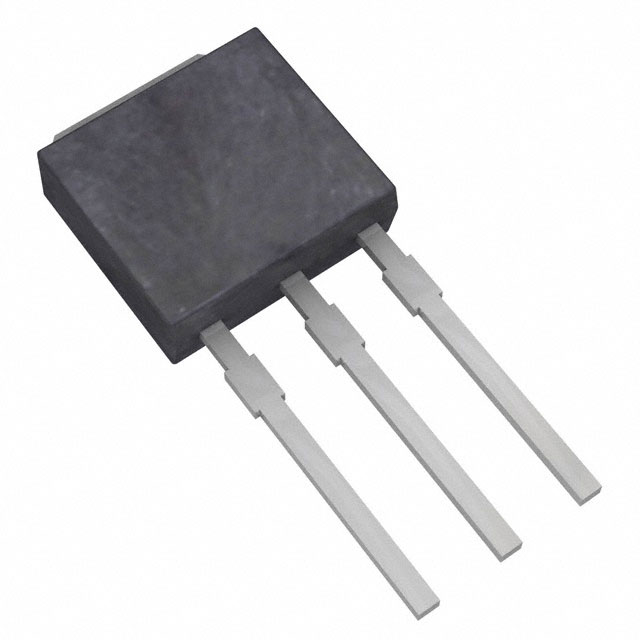FQU2N80TU
Introduction
The FQU2N80TU is a power MOSFET belonging to the category of electronic components used in various applications such as power supplies, motor control, and lighting. This entry provides an overview of the basic information, specifications, pin configuration, functional features, advantages and disadvantages, working principles, application field plans, and alternative models of the FQU2N80TU.
Basic Information Overview
- Category: Power MOSFET
- Use: Power supplies, motor control, lighting
- Characteristics: High voltage capability, low on-resistance, fast switching speed
- Package: TO-251
- Essence: Efficient power management
- Packaging/Quantity: Typically available in reels of 250 or 500 units
Specifications
- Voltage Rating: 800V
- Current Rating: 2A
- On-Resistance: 4.5Ω
- Gate Threshold Voltage: 2-4V
- Operating Temperature Range: -55°C to 150°C
Detailed Pin Configuration
The FQU2N80TU typically has three pins: 1. Gate (G): Input for controlling the switching behavior of the MOSFET 2. Drain (D): Connection to the load or power supply 3. Source (S): Common reference point and return path for the current
Functional Features
- High voltage capability allows for use in various high-power applications
- Low on-resistance minimizes power losses and improves efficiency
- Fast switching speed enables rapid response in switching applications
Advantages and Disadvantages
Advantages
- High voltage capability suitable for demanding applications
- Low on-resistance leads to reduced power dissipation
- Fast switching speed enhances overall performance
Disadvantages
- Higher gate threshold voltage may require specific drive circuitry
- Limited current rating compared to higher-power MOSFETs
Working Principles
The FQU2N80TU operates based on the principle of field-effect transistors, where the voltage applied to the gate terminal controls the flow of current between the drain and source terminals. When the gate-source voltage exceeds the threshold, the MOSFET enters the conducting state, allowing current to flow through it.
Detailed Application Field Plans
The FQU2N80TU finds applications in various fields including: - Switched-mode power supplies - Motor control circuits - LED lighting systems - Inverter and converter circuits
Detailed and Complete Alternative Models
Some alternative models to the FQU2N80TU include: - IRF840: Similar voltage and current ratings - STP16NF06: Comparable characteristics and package type - FQP27P06: Alternative with different polarity and characteristics
In conclusion, the FQU2N80TU power MOSFET offers high voltage capability, low on-resistance, and fast switching speed, making it suitable for diverse power management applications. Understanding its specifications, pin configuration, functional features, and alternative models provides valuable insights for its effective utilization in various electronic designs.
[Word Count: 430]
Senaraikan 10 soalan dan jawapan biasa yang berkaitan dengan aplikasi FQU2N80TU dalam penyelesaian teknikal
What is FQU2N80TU?
- FQU2N80TU is a power MOSFET transistor designed for high-speed switching applications.
What are the key features of FQU2N80TU?
- FQU2N80TU features low on-resistance, fast switching speed, and high voltage capability, making it suitable for various technical solutions.
In what technical solutions can FQU2N80TU be used?
- FQU2N80TU can be used in applications such as power supplies, motor control, lighting systems, and DC-DC converters.
What is the maximum voltage rating of FQU2N80TU?
- The maximum voltage rating of FQU2N80TU is 800V, allowing it to handle high voltage applications.
What is the typical on-resistance of FQU2N80TU?
- The typical on-resistance of FQU2N80TU is low, enabling efficient power management and reduced heat dissipation.
Does FQU2N80TU require a heat sink for operation?
- Depending on the application and power dissipation, FQU2N80TU may require a heat sink for optimal thermal performance.
Can FQU2N80TU be used in automotive applications?
- Yes, FQU2N80TU can be used in automotive applications such as electronic control units (ECUs) and motor drives.
What are the recommended operating conditions for FQU2N80TU?
- The recommended operating conditions include a specified gate-source voltage, drain current, and junction temperature for reliable performance.
Is FQU2N80TU RoHS compliant?
- Yes, FQU2N80TU is RoHS compliant, meeting environmental standards for lead-free and hazardous substance-free manufacturing.
Where can I find detailed technical specifications for FQU2N80TU?
- Detailed technical specifications for FQU2N80TU can be found in the datasheet provided by the manufacturer or distributor.


